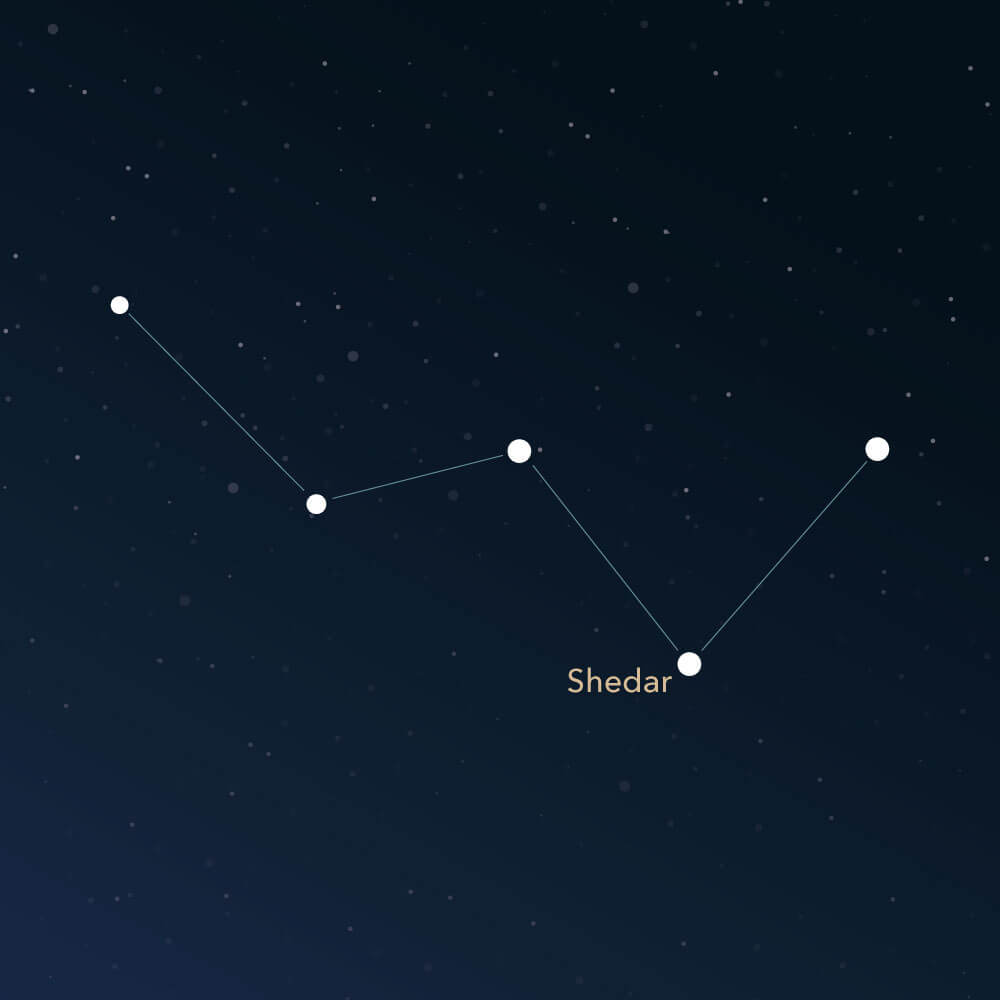The constellation Cassiopeia
Caratteristiche
- Nome latino
- Cassiopeia
- Emisfero
- Emisfero settentrionale
- Visibilità
- All year round
- Area
- 598 deg²
- Stella più luminosa
- Shedar (HIP number 3179)
- Specialità
- Open star clusters, emission nebula

Cassiopeia symbolizes the seated queen and is one of the 48 constellations described by the Greco-Roman astronomer Claudius Ptolemy in ancient times. It lies in a region of the sky rich in stars, resulting in several interesting deep-sky objects to observe.
Hemisphere, visibility, and area
The constellation Cassiopeia is located in the northern sky and is visible from all regions of the northern hemisphere. South of the equator, it is visible only up to the 12th latitude. This corresponds to places such as the north of Madagascar or Lima in Peru.
In latitudes such as Central Europe or Canada, it is circumpolar, meaning it is visible all year round. In southern regions, it can be best observed from October to February.
It stretches over 598 square degrees of the night sky, ranking it 25th among the other 88 constellations.
The five main stars form the striking shape of Cassiopeia. They are arranged in the letter W or an upside-down M in the sky. The middle tip of the letter points directly toward the direction of the North Star.
The brightest star in the constellation is Shedar (Latin: α Cassiopeiae, Alpha Cassiopeiae). It is a red giant located around 230 light-years from earth with an apparent magnitude of roughly 2.23.
Cassiopeia is embedded between five other constellations in the night sky. To the north and east lie Cepheus and Lacerta. To the south lies the well-known Andromeda constellation. To the west are the two constellations Perseus (southwest) and Camelopardalis.
Specialties in the constellation
The constellation Cassiopeia is traversed by the Milky Way, which provides for a number of open star clusters and an emission nebula.
One of the brightest open star clusters in the constellation is M52 (Messier 52), with an apparent magnitude of about 6.9. It was discovered by the French astronomer Charles Messier in 1774. M52 is estimated to be around 60 million years old, and its distance to the sun is approximately 4,600 light-years. M52 lies on the border to the constellation Cepheus, roughly along the extension of the right arm of the "W" shape. Even in binoculars, the star cluster can be perceived as a fuzzy patch.
Another open star cluster is the so-called Owl Cluster, also known as NGC 457. It received its nickname due to its appearance. As viewed through a telescope, the arrangement of its stars resembles an owl, with the brightest stars forming the eyes.
In addition to the numerous open star clusters, an interesting emission nebula can also be found in Cassiopeia. It has the catalog number NGC 281 and the nickname Pac-Man Nebula. Its distance from earth is approximately 9,500 light-years. In astronomical photographs, it appears as a blue nebula with a yellow-orange edge.

Mythology
In Greek mythology, the constellation represents the vain and self-confident queen Cassiopeia. She was the wife of King Cepheus and the mother of Andromeda.
Convinced of her and her daughter's beauty, Cassiopeia claimed they were more beautiful than the daughters of the titan Nereus. The daughters of Nereus, also called Nereids, were considered the embodiment of beauty at the time, and became angry after Cassiopeia's claim.
Amphitrite, a daughter of Nereus and the wife of the sea god Poseidon asked her husband for help in seeking revenge on Cassiopeia. Accordingly, he sent his sea monster Cetus into the kingdom of Cepheus and Cassiopeia.
Cetus mercilessly sank fishing boats and merchant ships. Fields near the coast were flooded with salty seawater, causing crop failures and halting sea trade and fishing. Finally, a famine broke out.
Desperately, Cepheus sought help from the oracle of Siwa. It said that Cetus would only disappear if Cepheus sacrificed his daughter Andromeda. Subsequently, Cepheus chained Andromeda to a rock on the coast. But before any harm could be done, the hero Perseus appeared. He rescued Andromeda and killed the monster Cetus.
As a reminder of this story, all involved parties were set as constellations in the sky.
PubblicatoLeggi altri articoli interessanti

An overview of all 88 constellations
Learn more about all 88 constellations and read interesting information about the mythology, visibility, and features.

App Planetario
Discover the night sky with our planetarium app!
Available for iOS and Android.

Dai un nome a una stella nella costellazione Seated Queen
Name a star in a constellation and create something that lasts for eternity.